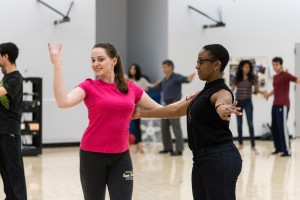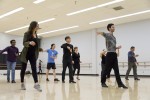Dancers of all ages and skill levels swivel their hips to the Backstreet Boys on the upper level of the John Wooden Center, unbeknownst to students focused on their nightly workouts below.
The music shifts to the guitar lines of classical Latin music, and the group splits into partners who rumba together.
The dancers of Dancesport Club at UCLA revived the national collegiate dance program during spring 2016. Student instructors hold Latin and ballroom classes that cater to both beginners and advanced dancers, with the ultimate goal of training their members to compete in national dancesport competitions, such as the upcoming dancesport competition at University of Southern California on Feb. 18. The team is comprised of mostly novice dancers, who adjusted to the competitive elements of dancesport in the short span of time leading up to their first competition at University of California Santa Barbara in early November 2016.
Dancesport’s open classes attract UCLA students and faculty members, as well as the occasional professor, said Bailey Loverin, dancesport member and graduate student in law.
[Related: Hip-hop dance group Foundations Choreography teaches basics to beginners]
Co-founder and instructor Vivian Delchamps, a graduate student in English, teamed up with co-founder Kenneth Kuo in spring to revitalize UCLA’s dancesport team, which had previously disbanded after becoming too small to be sustained. Delchamps, who was originally a ballet dancer, joined the Claremont Colleges Ballroom Dance Company while enrolled at Scripps College and embraced the world of competitive dance.
The two reached out to the dancesport teams at the Claremont Colleges and California Institute of Technology, who came to UCLA to perform and advertise the program in April. Although UCLA has social ballroom dancing organizations and other competitive teams, such as the Historical Ballroom Dance Club or ACA Hip Hop, dancesport provides a combination of classical ballroom training and opportunities to compete with other teams, Delchamps said.
“I just felt that it was an important space that needed to be filled at UCLA,” she said.
Dancesport breaks down into two main components, which include artistry and technique, said Taylor Lane Daymude, Latin dance instructor and third-year mathematics student.
Dancesport is as much an art form, which appeals to people who want to hone the creative element of dance, as it is a sport involving technical proficiency and competitive edge, he said.
“By having both of those in the same place, you draw all sorts of people,” Lane Daymude said.

UCLA lab technician Shawn Recinos said he doesn’t plan on dancing professionally because he only started three years prior, but attends classes to practice dance techniques with his partner. The range of ages in dancesport reflects how dancing manifests in the real world, he said.
“If you were to go out social dancing, it’s not just people your age – there’s older people and younger people,” he said. “It’s a mix.”
[Related: UCLA Nashaa wins first place at Bollywood America dance competition]
Since the program is new to UCLA, most people join the team without prior dance experience and participate in the two beginner series classes Dancesport Club at UCLA offers, Delchamps said.
In the beginning Latin class Friday night, dancers mimic Lane Daymude’s footwork in the mirror. He demonstrates stepping side to side, pulling the hips along, complete with a controlled opening of the arms. In the corner of the studio, an advanced dancer simultaneously flows through the convulsing movements of her own solo routine, lost in the music of her headphones.
Partnerships often arise out of two strangers dancing with each other in class, Delchamps said.
The rapid rotation of partners enables dancers to meet a lot of new people and find potential dance partners for competitions. During the class, dancers switch partners every minute and are greeted with excited hugs and brief greetings, before assuming their starting positions.
No time was wasted on awkward moments or adjustments as the partners moved through each step and spin, synchronized and focused on their technique.
The beginners, who had no prior dancing or competing experience, danced in front of a panel of judges just weeks after learning basic dance steps. Ballroom competitions, even at a national level, are accessible to beginners because they are divided up into so many different levels, so there are categories for everyone to compete in, Lane Daymude said.
Dancesport competitions have a rookie-veteran category where novices are paired with advanced dancers to facilitate beginners transitioning to competitive dance, Delchamps said. She said she beamed while watching them seamlessly execute steps she had taught them just weeks ago.
“Competing is actually a great way to improve,” Delchamps said. “When you have a goal in mind, you work a lot harder for it.”
Eight UCLA dancesport performers, as well as the instructors, competed in Beach Ball at UCSB Ballroom, Latin, & Nightclub Dance Competition. The team bonded both in practices as well as minutes before walking onto the dance floor, finishing each other’s hair in ballroom-ready updos.
“Having that team energy really helped soothe the nerves,” she said. “And then as soon as the dancing began, it was just adrenaline.”
Partner ballroom dancing is a universal skill that people can use their entire lives, whether at a salsa night with their friends or during a waltz at a wedding, Loverin said.
“The excitement we have for dance makes us all want to keep doing it,” Delchamps said. “It’s kind of addicting.”
